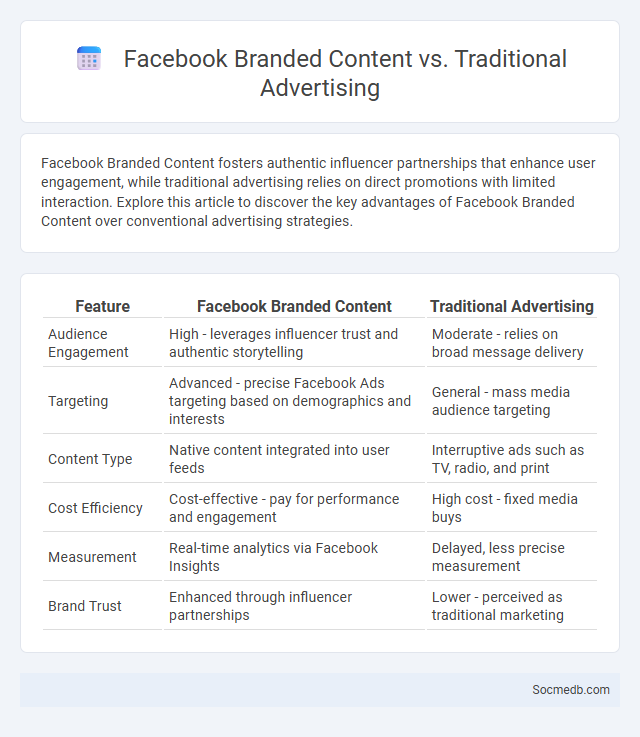
Photo illustration: Facebook Branded Content vs Traditional Advertising
Facebook Branded Content fosters authentic influencer partnerships that enhance user engagement, while traditional advertising relies on direct promotions with limited interaction. Explore this article to discover the key advantages of Facebook Branded Content over conventional advertising strategies.
Table of Comparison
| Feature | Facebook Branded Content | Traditional Advertising |
|---|---|---|
| Audience Engagement | High - leverages influencer trust and authentic storytelling | Moderate - relies on broad message delivery |
| Targeting | Advanced - precise Facebook Ads targeting based on demographics and interests | General - mass media audience targeting |
| Content Type | Native content integrated into user feeds | Interruptive ads such as TV, radio, and print |
| Cost Efficiency | Cost-effective - pay for performance and engagement | High cost - fixed media buys |
| Measurement | Real-time analytics via Facebook Insights | Delayed, less precise measurement |
| Brand Trust | Enhanced through influencer partnerships | Lower - perceived as traditional marketing |
Introduction to Facebook Branded Content
Facebook Branded Content allows creators and businesses to partner and authentically share sponsored posts with their audience, enhancing reach and engagement. This feature provides transparent advertising by clearly labeling paid partnerships, ensuring compliance with Facebook's policies and building trust with your followers. Leveraging Facebook Branded Content tools, you can optimize campaign performance through insights and audience targeting tailored to your brand goals.
Defining Traditional Advertising
Traditional advertising encompasses marketing strategies using established media channels such as television, radio, print newspapers, and magazines to reach broad audiences. Your brand's message is conveyed through carefully crafted commercials, billboards, and direct mail campaigns designed to build awareness and drive consumer action. Despite the rise of digital platforms, traditional advertising remains a foundational approach for reinforcing brand identity and delivering consistent content to target demographics.
What is Branded Content?
Branded content is a marketing technique where brands create engaging, relevant media that subtly promotes their products or values without direct advertising. This content often appears as stories, videos, or articles designed to resonate with your target audience, enhancing brand awareness and loyalty. By integrating your brand's message seamlessly, branded content fosters a more authentic connection with consumers.
Key Differences: Facebook Branded Content vs Traditional Advertising
Facebook branded content integrates influencer partnerships directly with your brand's message, offering authentic engagement and trust building, while traditional advertising relies on direct promotional messages that may appear less genuine. Branded content leverages storytelling through creators' audiences, increasing organic reach and interaction, whereas traditional ads focus on broader targeting through paid placements. Your choice should consider that branded content nurtures long-term relationships, while traditional ads deliver immediate, measurable results.
Key Differences: Facebook Branded Content vs Branded Content
Facebook Branded Content specifically refers to posts where influencers or creators tag a business partner, allowing brands to transparently promote products while maintaining authenticity and compliance with Facebook's policies. Branded Content, in a broader social media context, encompasses any promotional material created or shared by creators or brands to engage audiences but may lack the native tagging and analytics tools unique to Facebook's platform. You benefit from Facebook Branded Content's enhanced tracking, audience targeting, and monetization features, which provide clear insights and compliance that generic Branded Content does not offer.
Audience Engagement: Which Method Wins?
Audience engagement on social media excels through interactive content like polls, quizzes, and live videos that encourage active participation. Personalized responses and timely interactions boost your connection with followers, driving higher retention and loyalty. Analyzing engagement metrics regularly helps tailor strategies to your unique audience preferences, ensuring sustained growth.
Performance Metrics: Tracking ROI and Effectiveness
Social media performance metrics such as engagement rate, click-through rate (CTR), conversion rate, and follower growth are critical for tracking ROI and effectiveness. Tools like Google Analytics, Facebook Insights, and Hootsuite enable precise measurement of campaign impact, enabling data-driven decisions. Monitoring cost per acquisition (CPA) and return on ad spend (ROAS) further ensures optimization of marketing budgets for maximum social media success.
Content Authenticity and Consumer Trust
Content authenticity on social media plays a crucial role in building consumer trust by ensuring that information shared is genuine, transparent, and verifiable. You can enhance your brand reputation and engagement by consistently delivering authentic messages that resonate with your audience's values and expectations. Platforms employing verification tools and anti-fake measures help safeguard content integrity, fostering a reliable environment where consumers feel confident interacting with your brand.
Costs and Budget Considerations
Managing costs and budget considerations is crucial for maximizing your social media ROI while avoiding unnecessary expenses. You should allocate funds strategically across content creation, paid advertisements, and tools for analytics and scheduling, ensuring each dollar drives measurable engagement and growth. Monitoring spending regularly helps optimize campaigns and prevent budget overruns.
Choosing the Right Strategy for Your Brand
Selecting the right social media strategy for your brand involves identifying your target audience and tailoring content that resonates with their interests and behaviors. Utilizing data-driven insights to optimize posting schedules, platform choices, and engagement methods enhances brand visibility and customer interaction. Your brand's success hinges on consistent messaging aligned with core values and measurable goals to track performance effectively.
 socmedb.com
socmedb.com